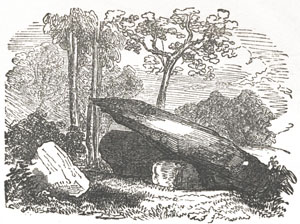Celtic Druids

Cromlech at Castle Mary, Cloyne
The Religion of Ancient Erinn—The Druids and their Teaching—The Irish were probably Fire-worshippers—The Customs of Ancient Erinn—Similarity between Eastern and Irish Customs—Beal Fires—Hunting the Wren—"Jacks," a Grecian game—"Keen," an Eastern Custom—Superstitions—The Meaning of the Word—What Customs are Superstitious and what are not—Holy Wells—The Laws of Ancient Erinn—Different kinds of Laws—The Lex non Scripta and the Lex Scripta—Christianity necessitated the Revision of Ancient Codes—The Compilation of the Brehon Laws—Proofs that St. Patrick assisted thereat—Law of Distress—Law of Succession—The Language of Ancient Erinn—Writing in pre-Christian Erinn—Ogham Writing—Antiquities of pre-Christian Erinn—Round Towers—Cromlechs—Raths—Crannoges.

ASTERN customs and eastern superstitions, which undoubtedly are a strong confirmatory proof of our eastern origin, abounded in ancient Erinn. Druidism was the religion of the Celts, and druidism was probably one of the least corrupt forms of paganism. The purity of the divinely-taught patriarchal worship, became more and more corrupted as it passed through defiled channels. Yet, in all pagan mythologies, we find traces of the eternal verity in an obvious prominence of cultus offered to one god above the rest; and obvious, though grossly misapplied, glimpses of divine attributes, in the many deified objects which seemed to symbolize his power and his omnipotence. The Celtic druids probably taught the same doctrine as the Greek philosophers.
The metempsychosis, a prominent article of this creed, may have been derived from the Pythagoreans, but more probably it was one of the many relics of patriarchal belief which were engrafted on all pagan religions. They also taught that the universe would never be entirely destroyed, supposing that it would be purified by fire and water from time to time. This opinion may have been derived from the same source. The druids had a pontifex maximus, to whom they yielded entire obedience,—an obvious imitation of the Jewish custom. The nation was entirely governed by its priests, though after a time, when the kingly power developed itself, the priestly power gave place to the regal. Gaul was the head-quarters of druidism; and thither we find the Britons, and even the Romans, sending their children for instruction. Eventually, Mona became a chief centre for Britain. The Gaedhilic druids, though probably quite as learned as their continental brethren, were more isolated; and hence we cannot learn so much of their customs from external sources. There is no doubt that the druids of Gaul and Britain offered human sacrifices; it appears almost certain the Irish druids did not.
Our principal and most reliable information about this religion, is derived from Caesar. His account of the learning of its druids, of their knowledge of astronomy, physical science, mechanics, arithmetic, and medicine, however highly coloured, is amply corroborated by the casual statements of other authors.[9] He expressly states that they used the Greek character in their writings, and mentions tables found in the camp of the Helvetia written in these characters, containing an account of all the men capable of bearing arms.
Notes
[9] Authors.—Strabo, 1. iv. p. 197; Suetonius, V. Cla. ; Pliny, Hist. Nat. 1. xxv. c. 9. Pliny mentions having seen the serpent's egg, and describes it.
